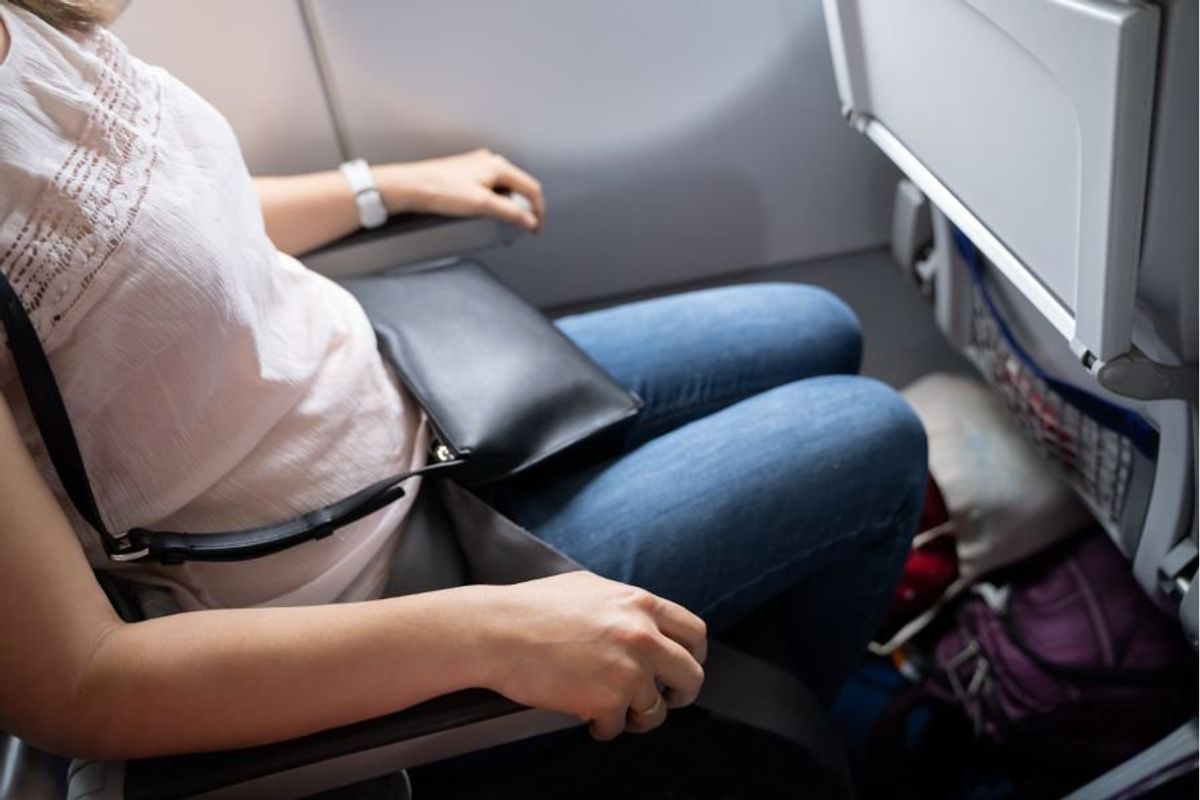The 'middle seat rule' and other unspoken airplane etiquette passengers should know
How are people who don't travel frequently supposed to know these things?

Avoid common faux pas on airplanes with these unwritten rules.
When you fly on an airplane, you agree to abide the passenger rules set by the Federal Aviation Administration (FAA), even if you don't know what all of them are. If a crew member catches you breaking an FAA rule, they will definitely let you know. But there are other "rules" of airline travel, largely unspoken and unwritten, that people who fly frequently abide by as well. If you don't travel a lot, you may not be aware of these rules, and it's not likely that someone will tell you if you break them, but knowing them makes air travel much more pleasant for everyone.
The middle seat rule
Most people have a preference for which seat they prefer—window, middle or aisle—with almost no one preferring to sit in the middle. (According to a survey from Going, 53% of people prefer the window seat, 46% prefer the aisle and a whopping 1% want the middle seat.) The window seat gets the views and control of the window shade and the aisle seat gets extra elbow room and controls when the row exits, but the middle seat only seems to come with down sides. Since the middle seat is basically the booby prize of air travel, the person who occupies it deserves to have at least one perk—control over the middle armrests.

The middle seat rule means that the aisle and window seat occupants let person in the middle seat use the two middle armrests. What else do those poor souls have, really?
The rules of reclining
Few airline etiquette topics are more contentious than the "right to recline." The vast majority of economy airline seats have a button that allows the seat back to recline a few inches, but whether or not you should use it is a question without a clear answer. It's become even more of a question mark in the era of ever-shrinking legroom, with passengers fighting for every inch of space they can get.
Though people have strong opinions one way or the other, the general consensus for reclining "rules" seems to be that the courteous thing to do is 1) alert the person behind you that you want to recline, 2) don't recline during a meal, 3) avoid reclining on short-haul flights, 4) don't recline on someone who is using a laptop, and 5) when you do recline, ease the seat back slowly.
The headphones rule
There are actually two rules when it comes to headphones: 1) Wear them if you're watching or listening to something. No one wants to hear whatever you're watching or listening to. And 2) If someone's wearing headphones, don't try to chat them up.

Some people are airplane talkers and some aren't, but headphones a surefire way to signal that you're not up for chatting with strangers. If someone is wearing headphones or earbuds, that's a clear "please don't talk to me" sign, so unless there's something you really have to ask or tell someone wearing them, leave them to themselves.
The headrest rule
We all know getting in and out of the middle or window seats to go to the restroom can be a challenge, but if at all possible, try to avoid grabbing onto the headrests of the seats in front of you for leverage. It's better to move more slowly to climb your way across the seats than to seize someone's headrest like it's a grab bar. If you've ever tried to nap on a plane and had your headrest yanked suddenly with someone's full body weight, you understand this rule first hand.
The rules of deplaning
Getting onto a flight is a pretty orderly process since there are assigned seats and boarding groups and whatnot. But getting off the plane is another story. As soon as the plane parks at the gate and the seatbelt sign is turned off, it feels like the whole plane collectively thinks they'll just be able to stand up and walk off, but that's not how it works.

First of all, it takes several minutes to get the plane doors ready to open, so standing up and filing into the aisle is a fairly useless practice (which also tends to make people feel a bit impatient). Sitting tight until the first people start actually deplaning keeps things a bit more relaxed.
But more importantly, some people seem to think deplaning is a free-for-all, with whoever can make it into the aisle with their luggage first taking priority, but that's not how it works. Emptying the plane row by row from the front to the back is The Way, so waiting patiently until the rows in front of you empty before filing out makes deplaning more efficient and less hectic.
Most unspoken rules, on airplanes or elsewhere, are based on common sense and/or courtesy. But since air travel comes with its own unique peculiarities, what's sensible or courteous may not be obvious, so it helps to have those rules explained. When everyone on the plane is on the same page, it makes for a much more pleasant travel experience for all.
- A toddler on her flight cried for 2 full hours. Her response a masterclass in kindness. ›
- People are admitting the 'dumbest' travel mistakes they've made, and the cringe is real ›
- The one hard and fast rule when your flight gets canceled or delayed and you're stranded ›
- How dad got his son to use 'please' and 'thank you' with made-up cat story - Upworthy ›
- Why elbows on the dinner table is an etiquette no-no - Upworthy ›






 Beaver in water. Photo by
Beaver in water. Photo by  An actual beaver dam on the now-thriving Price River
An actual beaver dam on the now-thriving Price River
 Not just coworkers—family, friends, strangers, kids…
Not just coworkers—family, friends, strangers, kids… Imagine having to go so badly but being out of euros.
Imagine having to go so badly but being out of euros.  Anything hobbit-esque can't be wrong.
Anything hobbit-esque can't be wrong.  But what if you need pain meds AND mascara?!
But what if you need pain meds AND mascara?! Imagine how this would affect childcare.
Imagine how this would affect childcare. Honestly…where's the lie?
Honestly…where's the lie? A brown buddha statue sits near a green mountain. Photo by
A brown buddha statue sits near a green mountain. Photo by  Urgent dash to the bathroom! 🚪🏃♂️
Urgent dash to the bathroom! 🚪🏃♂️ Ladybug unexpectedly found during colonoscopyPhoto credit:
Ladybug unexpectedly found during colonoscopyPhoto credit:  Close-up of bottom of ladybug found in colonPhoto credit:
Close-up of bottom of ladybug found in colonPhoto credit:
There's a reason why some people can perfectly copy accents, and others can't
Turns out, there's a neurodivergent link.
A woman in black long sleeve shirt stands in front of mirror.
Have you ever had that friend who goes on vacation for four days to London and comes back with a full-on Queen's English posh accent? "Oooh I left my brolly in the loo," they say, and you respond, "But you're from Colorado!" Well, there are reasons they (and many of us) do that, and usually it's on a pretty subconscious level.
It's called "accent mirroring," and it's actually quite common with people who are neurodivergent, particularly those with ADHD (Attention Deficit Hyperactivity Disorder). According Neurolaunch, the self-described "Free Mental Health Library," "Accent mirroring, also known as accent adaptation or phonetic convergence, is the tendency to unconsciously adopt the accent or speech patterns of those around us. This linguistic chameleon effect is not unique to individuals with ADHD, but it appears to be more pronounced and frequent in this population."
Essentially, when people have conversations, we're constantly "scanning" for information—not just the words we're absorbing, but the inflection and tone. "When we hear an accent, our brains automatically analyze and categorize the phonetic features, prosody, and intonation patterns," writes Neurolaunch. For most, this does result in copying the accent of the person with whom we're speaking. But those with ADHD might be more sensitive to auditory cues. This, "coupled with a reduced ability to filter out or inhibit the impulse to mimic…could potentially explain the increased tendency for accent mirroring."
While the article explains further research is needed, they distinctly state that, "Accent mirroring in individuals with ADHD often manifests as an unconscious mimicry of accents in social situations. This can range from subtle shifts in pronunciation to more noticeable changes in intonation and speech rhythm. For example, a person with ADHD might find themselves unconsciously adopting a Southern drawl when conversing with someone from Texas, even if they’ve never lived in the South themselves."
People are having their say online. On the subreddit r/ADHDWomen, a thread began: "Taking on accents is an ADHD thing?" The OP shares, "My whole life, I've picked up accents. I, myself, never noticed, but everyone around me would be like, 'Why are you talking like that??' It could be after I watched a show or movie with an accent or after I've traveled somewhere with a different accent than my 'normal.'
They continue, "Apparently, I pick it up fast, but it fades out slowly. Today... I'm scrolling Instagram, I watch a reel from a comedian couple (Darcy and Jeremy. IYKYK) about how Darcy (ADHD) picks up accents everywhere they go. It's called ADHD Mirroring??? And it's another way of masking."
(The OP is referring to Darcy Michaels and his husband Jeremy Baer, who are both touring comedians based in Canada.)
Hundreds of people on the Reddit thread alone seem to relate. One comments, "Omfg I've done this my whole life; I'll even pick up on the pauses/spaces when I'm talking to someone who is ESL—but English is my first language lol."
Sometimes, it can be a real issue for those around the chameleon. "I accidentally mimicked a waitress's weird laugh one time. As soon as she was out of earshot, my family started to reprimand me, but I was already like 'oh my god I don’t know why I did that, I feel so bad.'"
Many commenters on TikTok were shocked to find out this can be a sign of ADHD. One jokes, "Omg, yes, at a store the cashier was talking to me and she was French. She's like 'Oh are you French too? No, I'm not lol. I'm very east coast Canada."
And some people just embrace it and make it work for them. "I mirror their words or phrase! I’m 30. I realized I start calling everyone sweetie cause my manager does & I work at coffee shop."